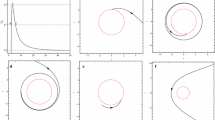Abstract
Spacetime metrics describing ‘non-singular’ black holes are commonly studied in the literature as effective modification to the Schwarzschild solution that mimic quantum gravity effects removing the central singularity. Here we point out that to be physically plausible, such metrics should also incorporate the 1-loop quantum corrections to the Newton potential and a non-trivial time delay between an observer at infinity and an observer in the regular center. We present a modification of the well-known Hayward metric that features these two properties. We discuss bounds on the maximal time delay imposed by conditions on the curvature, and the consequences for the weak energy condition, in general violated by the large transversal pressures introduced by the time delay.













Similar content being viewed by others
Notes
It is worth mentioning that the metric proposed by Bardeen in [5] does reproduce the required behaviour of the newtonian potential. On the other hand, as well as all the line elements proposed, it suffers for the time delay problem.
In the numerical plots, we use the value \(\beta =41/10\pi \).
References
Wald, R.M.: General Relativity. University of Chicago Press, Chicago (2010)
Hawking, S.W., Ellis, G.F.R.: The Large Scale Structure of Space-Time, vol. 1, 20th edn. Cambridge University Press, Cambridge (1973)
Ashtekar, A., Pawlowski, T., Singh, P.: Quantum nature of the big bang. Phys. Rev. Lett. 96, 141301 (2006). gr-qc/0602086
Rovelli, C., Vidotto, F.: Planck Stars. (2014). arXiv:1401.6562
Bardeen, J.M.: Non-singular general-relativistic gravitational collapse. In: Proceedings of International Conference GR5, Tbilisi, p. 174 (1968)
Frolov, V.P., Vilkovisky, G.: Spherically symmetric collapse in quantum gravity. Phys. Lett. B 106, 307–313 (1981)
Roman, T.A., Bergmann, P.G.: Stellar collapse without singularities? Phys. Rev. D 28, 1265–1277 (1983)
Mazur, P. O., and Mottola, E.: Gravitational condensate stars: An alternative to black holes, gr-qc/0109035
Dymnikova, I.: Cosmological term as a source of mass. Class. Quantum Gravity 19, 725–740 (2002). gr-qc/0112052
Hayward, S.A.: Formation and evaporation of regular black holes. Phys. Rev. Lett. 96, 31103 (2006). gr-qc/0506126
Nicolini, P., Smailagic, A., Spallucci, E.: Noncommutative geometry inspired Schwarzschild black hole. Phys. Lett. B 632, 547 (2006). gr-qc/0510112
Falls, K., Litim, D.F., Raghuraman, A.: Black holes and asymptotically safe gravity. Int. J. Mod. Phys. A 27, 1250019 (2012). arXiv:1002.0260
Modesto, L., Moffat, J.W., Nicolini, P.: Black holes in an ultraviolet complete quantum gravity. Phys. Lett. B 695, 397 (2011). arXiv:1010.0680
Frolov, V.P.: Information loss problem and a ‘black hole’ model with a closed apparent horizon. (2014). arXiv:1402.5446
Haggard, H.M., Rovelli, C.: Black hole fireworks: quantum-gravity effects outside the horizon spark black to white hole tunneling. arXiv:1407.0989
Mersini-Houghton, L.: Backreaction of hawking radiation on a gravitationally collapsing star I: Black holes? PLB30496 Phys. Lett. B (2014). arXiv:1406.1525
Frolov, V.P.: Do Black Holes Exist? arXiv:1411.6981
Ansoldi, S.: Spherical black holes with regular center: a review of existing models including a recent realization with Gaussian sources. (2008). arXiv:0802.0330
Bjerrum-Bohr, N.E.J., Donoghue, J.F., Holstein, B.R.: Quantum gravitational corrections to the nonrelativistic scattering potential of two masses. Phys. Rev. D 67, 084033 (2003). hep-th/0211072
Dymnikova, I.: Vacuum nonsingular black hole. Gen. Relativ. Gravit 24, 235–242 (1992)
Borde, A.: Regular black holes and topology change. Phys. Rev. D 55, 7615–7617 (1997). gr-qc/9612057
Frolov, V.P., Markov, M., Mukhanov, V.F.: Through a black hole into a new universe? Phys. Lett. B 216, 272–276 (1989)
Rovelli, C., Vidotto, F.: Covariant Loop Quantum Gravity. Cambridge University Press, Cambridge (2014)
Ashtekar, A., Bojowald, M.: Black hole evaporation: a paradigm. Class. Quantum Gravity 22, 3349–3362 (2005). gr-qc/0504029
Bianchi, E., De Lorenzo, T., Smerlak, M.: Entanglement entropy production in gravitational collapse: covariant regularization and solvable models. arXiv:1409.0144
Perez, A.: No firewalls in quantum gravity: the role of discreteness of quantum geometry in resolving the information loss paradox. arXiv:1410.7062
Barrau, A., Rovelli, C.: Planck star phenomenology. (2014). arXiv:1404.5821
Barrau, A., Rovelli, C., Vidotto, F.: Fast radio bursts and white hole signals. arXiv:1409.4031
Donoghue, J.F.: The effective field theory treatment of quantum gravity. In: Proceedings of AIP Conference 1483, 73–94 (2012). arXiv:1209.3511
Acknowledgments
We kindly acknowledge support from the A*MIDEX project ANR-11-IDEX-0001-02, as well as the Samy Maroun Center For Space, Time and the Quantum.
Author information
Authors and Affiliations
Corresponding author
Rights and permissions
About this article
Cite this article
De Lorenzo, T., Pacilio, C., Rovelli, C. et al. On the effective metric of a Planck star. Gen Relativ Gravit 47, 41 (2015). https://doi.org/10.1007/s10714-015-1882-8
Received:
Accepted:
Published:
DOI: https://doi.org/10.1007/s10714-015-1882-8




